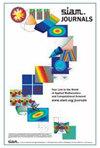在贝叶斯逆问题中选择观测操作符以减少模型误差
IF 1.9
3区 工程技术
Q2 MATHEMATICS, INTERDISCIPLINARY APPLICATIONS
引用次数: 0
摘要
SIAM/ASA《不确定性量化期刊》,第12卷,第3期,第723-758页,2024年9月。 摘要.在统计推断中,生成数据的参数-可观测映射与用于推断的参数-可观测映射之间的差异会导致似然值的错误规范,从而导致不正确的估计。在许多反演问题中,参数-可观测映射是一个称为 "观测算子 "的线性状态-可观测映射和一个称为 "模型 "的可能非线性参数-状态映射的组合。我们考虑的这类贝叶斯逆问题中,参数到可观测图的差异是由于使用了与最佳模型不同的近似模型,即非零 "模型误差 "造成的。为解决这种差异,人们提出了多种方法,每种方法都会导致特定的后验。我们展示了如何利用后验相对于似然扰动的局部 Lipschitz 稳定性估计来约束每种方法的后验相对于最佳模型相关后验的 Kullback-Leibler 分歧。我们的界限为选择观测算子提供了标准,从而减轻了贝叶斯逆问题中模型误差的影响。我们在一个平流-扩散-反应 PDE 逆问题上说明了这种标准的可行性,并用这个例子讨论了模型误差感知推理的重要性和挑战。本文章由计算机程序翻译,如有差异,请以英文原文为准。
Choosing Observation Operators to Mitigate Model Error in Bayesian Inverse Problems
SIAM/ASA Journal on Uncertainty Quantification, Volume 12, Issue 3, Page 723-758, September 2024.
Abstract.In statistical inference, a discrepancy between the parameter-to-observable map that generates the data and the parameter-to-observable map that is used for inference can lead to misspecified likelihoods and thus to incorrect estimates. In many inverse problems, the parameter-to-observable map is the composition of a linear state-to-observable map called an “observation operator” and a possibly nonlinear parameter-to-state map called the “model.” We consider such Bayesian inverse problems where the discrepancy in the parameter-to-observable map is due to the use of an approximate model that differs from the best model, i.e., to nonzero “model error.” Multiple approaches have been proposed to address such discrepancies, each leading to a specific posterior. We show how to use local Lipschitz stability estimates of posteriors with respect to likelihood perturbations to bound the Kullback–Leibler divergence of the posterior of each approach with respect to the posterior associated to the best model. Our bounds lead to criteria for choosing observation operators that mitigate the effect of model error for Bayesian inverse problems of this type. We illustrate the feasibility of one such criterion on an advection-diffusion-reaction PDE inverse problem and use this example to discuss the importance and challenges of model error-aware inference.
Abstract.In statistical inference, a discrepancy between the parameter-to-observable map that generates the data and the parameter-to-observable map that is used for inference can lead to misspecified likelihoods and thus to incorrect estimates. In many inverse problems, the parameter-to-observable map is the composition of a linear state-to-observable map called an “observation operator” and a possibly nonlinear parameter-to-state map called the “model.” We consider such Bayesian inverse problems where the discrepancy in the parameter-to-observable map is due to the use of an approximate model that differs from the best model, i.e., to nonzero “model error.” Multiple approaches have been proposed to address such discrepancies, each leading to a specific posterior. We show how to use local Lipschitz stability estimates of posteriors with respect to likelihood perturbations to bound the Kullback–Leibler divergence of the posterior of each approach with respect to the posterior associated to the best model. Our bounds lead to criteria for choosing observation operators that mitigate the effect of model error for Bayesian inverse problems of this type. We illustrate the feasibility of one such criterion on an advection-diffusion-reaction PDE inverse problem and use this example to discuss the importance and challenges of model error-aware inference.
求助全文
通过发布文献求助,成功后即可免费获取论文全文。
去求助
来源期刊

Siam-Asa Journal on Uncertainty Quantification
Mathematics-Statistics and Probability
CiteScore
3.70
自引率
0.00%
发文量
51
期刊介绍:
SIAM/ASA Journal on Uncertainty Quantification (JUQ) publishes research articles presenting significant mathematical, statistical, algorithmic, and application advances in uncertainty quantification, defined as the interface of complex modeling of processes and data, especially characterizations of the uncertainties inherent in the use of such models. The journal also focuses on related fields such as sensitivity analysis, model validation, model calibration, data assimilation, and code verification. The journal also solicits papers describing new ideas that could lead to significant progress in methodology for uncertainty quantification as well as review articles on particular aspects. The journal is dedicated to nurturing synergistic interactions between the mathematical, statistical, computational, and applications communities involved in uncertainty quantification and related areas. JUQ is jointly offered by SIAM and the American Statistical Association.
 求助内容:
求助内容: 应助结果提醒方式:
应助结果提醒方式:


